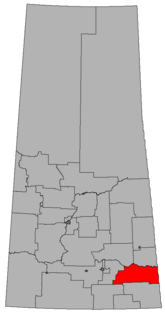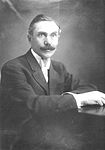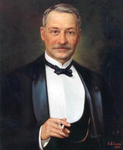
The Progressive Conservative Party of Saskatchewan is a right-of-centre political party in the Canadian province of Saskatchewan. Prior to 1942, it was known as the Conservative Party of Saskatchewan. Members are commonly known as Tories.

Sir Frederick William Alpin Gordon Haultain was a lawyer and a long-serving Canadian politician and judge. His career in provincial and territorial legislatures stretched into four decades. He served as the first premier of the Northwest Territories from 1897 to 1905 as is recognized as having a significant contribution towards the creation of the provinces of Alberta and Saskatchewan. From 1905 on he served as Leader of the Official Opposition in Saskatchewan as well as Leader of the Provincial Rights Party. His legislative career ended when he was appointed to the judiciary in 1912.

The Saskatchewan general election of 1908 was the second provincial election in the Canadian province of Saskatchewan. It was held on August 14, 1908 to elect members of the Legislative Assembly of Saskatchewan. Premier Walter Scott and his Liberal Party were re-elected for a second term, defeating the Provincial Rights Party of Frederick W. A. G. Haultain.

The Saskatchewan general election of 1912 was the third provincial election in the Canadian province of Saskatchewan. It was held on July 11, 1912 to elect members of the Legislative Assembly of Saskatchewan. Premier Walter Scott led the Liberal Party of Saskatchewan to a third term in office with a significant increase in the share of the popular vote. The opposition, now renamed from the Provincial Rights Party to the Conservative Party of Saskatchewan and led by Wellington Bartley Willoughby, lost both votes and seats in the legislature.

The Saskatchewan general election of 1917 was the fourth provincial election in the Canadian province of Saskatchewan. It was held on June 26, 1917, to elect members of the Legislative Assembly of Saskatchewan.

The Saskatchewan general election of 1921 was the fifth provincial election held in the Canadian province of Saskatchewan. It was held on June 9, 1921 to elect members of the Legislative Assembly of Saskatchewan.

The Saskatchewan general election of 1944 was the tenth provincial election in the Canadian province of Saskatchewan. It was held on June 15, 1944 to elect members of the Legislative Assembly of Saskatchewan.

The Saskatchewan general election of 1975 was the eighteenth provincial election held in the Canadian province of Saskatchewan. It was held on June 11, 1975, to elect members of the Legislative Assembly of Saskatchewan. Blakeney and the NDP were re-elected to a majority government.

Cannington is a provincial electoral district for the Legislative Assembly of Saskatchewan, Canada. Located in the extreme southeast corner of the province, this constituency was redrawn to include the former district of Souris for the 18th Saskatchewan general election in 1975.

Moosomin is a provincial electoral district for the Legislative Assembly of Saskatchewan, Canada. Located in southeastern Saskatchewan, this constituency was one of 25 created for the 1st Saskatchewan general election in 1905.

Fort Saskatchewan-Vegreville is a provincial electoral district in Alberta, Canada. The district is mandated to return a single member to the Legislative Assembly of Alberta using the first-past-the-post method of voting.
The Northwest Territories Liberal-Conservative Party also known formally as the Liberal-Conservative Association prior to 1903 and the Territorial Conservative Association after 1903, was a short lived political party in the Northwest Territories, Canada. from 1897–1905. It was a branch of the federal Conservative Party of Canada.
South Qu'Appelle is a former provincial electoral division for the Legislative Assembly of the province of Saskatchewan, Canada. The district was created before the 1st Saskatchewan general election in 1905, and abolished before the 8th Saskatchewan general election in 1934. It was the riding of former Premier of the North-West Territories and Saskatchewan Opposition leader Frederick Haultain.
Pelly is a former provincial electoral district for the Legislative Assembly of the province of Saskatchewan, Canada. Located in east-central Saskatchewan, it was centered on the village of Pelly. The riding was created before the 2nd Saskatchewan general election in 1908, and dissolved before the 23rd Saskatchewan general election in 1995. This constituency elected the first woman to the Saskatchewan legislature: Sarah Ramsland.
Kinistino was a provincial electoral district for the Legislative Assembly of the province of Saskatchewan, Canada. Located in north-central Saskatchewan, it was centred on the town of Kinistino. This constituency was one of 25 created for the 1st Saskatchewan general election in 1905.
Maple Creek is a former provincial electoral district for the Legislative Assembly of the province of Saskatchewan, Canada, centered on the town of Maple Creek. This district was one of 25 created for the 1st Saskatchewan general election in 1905. It was dissolved and merged with part of the Shaunavon riding before the 23rd Saskatchewan general election in 1995 to form the constituency of Cypress Hills.
Shellbrook was a provincial electoral district for the Legislative Assembly of the province of Saskatchewan, Canada, in the area of Shellbrook, Saskatchewan, west of Prince Albert.
Saltcoats was a provincial electoral district for the Legislative Assembly of the province of Saskatchewan, Canada, centered on the town of Saltcoats. One of 25 districts created before the 1st Saskatchewan general election in 1905, it was abolished before the 8th Saskatchewan general election in 1934.

The 1st Legislative Assembly of Saskatchewan was elected in the Saskatchewan general election held in December 1905, the first general election for the new province. The assembly sat from March 29, 1906, to July 20, 1908. The Liberal Party led by Walter Scott formed the government. The Provincial Rights Party led by Frederick Haultain formed the official opposition.















